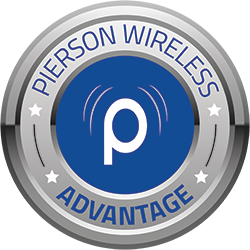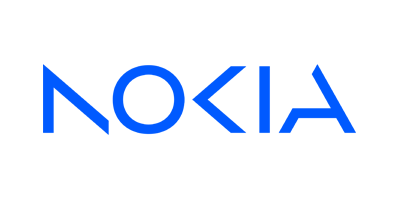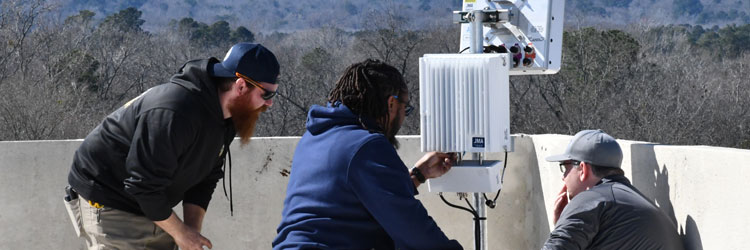If your building is experiencing any (or all) of those performance issues by your network, it can be a sign the capabilities of your in-building distributed antenna system (DAS) have been outpaced by the advances in cellular technology utilized by carriers, indicating it could be time to upgrade your DAS. Cellular DAS is a network of antennas connected to a common signal source that sends and receives network signals within a defined space, improving users’ cellular voice and data connectivity.
Poor system performance creates a negative user experience, impacts productivity, and leads to frustration from users who rely on wireless connectivity to perform daily functions. Wireless industry analysts state as much as 80 percent of all cellular network demand occurs inside buildings, and demand and data consumption will continue to increase exponentially as carriers continue the nationwide rollout of 5G services and innovators tap into the additional bandwidth and speed made available by the generational advancement in the network.
DAS has been integral to carriers’ and enterprise users’ telecommunications infrastructure for nearly four decades. Like all forms of technology, a legacy DAS eventually needs to be replaced to keep pace with the rapidly evolving demands of modern telecommunications.
There are two primary reasons why a DAS reaches an “End of Life” state and needs to be upgraded – frequencies and features.
Why are Frequencies a Challenge?
3G networks leveraged 850 MHz and Personal Communication Service (PCS, 1850-1990 MHz) spectrum.
The advent of 4G brought the addition of 700 MHz and Advanced Wireless Services (AWS, 1710-2155 MHz) onto DAS.
The fifth-generation (5G) introduction brought the advent of millimeter wave (mmWave) frequencies like 24 GHz, 28 GHz, and 39 GHz. These extremely high frequencies are fast, producing increased bandwidth but providing a limited range.
The propagation limits of mmWave required the addition of sub-6.0 GHz ultra-wideband spectrum bands like Broadband Radio Service (BRS, 2.5 GHz), Citizens Broadband Radio Service (CBRS, 3.55-3.7 GHz), and C-Band (3.45 & 3.7-3.98 GHz).
The evolution of preferred carrier spectrums has played the most significant role in carrying a legacy DAS into an End of Life state. User expectations aren’t met because older DAS cannot leverage the newest frequencies and services made available by carriers. Put simply, a user’s cellular experience can be drastically different outside and inside the building because the signal outside the building originates from carrier towers featuring all the latest frequencies, enabling the best user experience on their respective cell phones. Additional issues can arise when those newer frequencies from a carrier’s outdoor network penetrate a building at suboptimal signal levels for downlink and uplink, creating problems for newer end-user devices capable of 5G ultra-wideband spectrum. The differences in the quality of the signal and the quality of service of the end-user device lead to user frustration, eventually becoming an issue for the building and DAS owner.
Looking ahead and at the future of 5G and artificial intelligence (AI) enhanced applications, the increased demand placed on data speeds in the downlink and uplink will create bottlenecks and a poor service experience for end users if an upgraded DAS isn’t in place. Telecommunications industry experts are discussing a three-year window (2025-2028) to address this issue and create preparedness. Essentially, it’s been described that if the cellular wireless networks we utilize aren’t evolved, the uplink will break circa 2028. Thus, carriers are upgrading and densifying their networks for existing and new macro site deployments.
What Features are Available with an Upgraded DAS?
The primary reason to upgrade a legacy DAS is to take advantage of the many features offered by 5G frequencies and services. 5G brings a whole new set of features over its predecessor. It delivers enhanced mobile broadband and high-speed data rates. It also brings extreme capacity. Achieving these features depends on how your network and DAS were built.
Users that upgrade their DAS to 5G compatibility will tap into these immediate benefits:
Shouldn’t a Carrier Upgrade My DAS?
Over the last half-decade, carriers’ interest in supporting enterprise DAS has evolved quite a bit. Originally, carriers were interested in supporting enterprise DAS because those business customers had corporately liable lines of service for employees. Carriers knew precisely how many lines of service were in a customer’s building and what percentage of its occupants utilized their service.
More recently, many companies have shifted to individually liable, bring-your-own-device scenarios that no longer guarantee that a plurality of users in a building are with one carrier. This shift in corporate behavior has offset the carriers’ justification for DAS in many enterprise situations. That’s not to say carriers no longer support DAS for enterprise customers, as they will be under particular situations with proven upsides for the carrier. Still, financial support for carrier-paid upgrades has significantly changed during this decade.

Why Choose Pierson Wireless for My DAS Upgrade?
When upgrading your DAS, trust the experts with a proven track record of success. Pierson Wireless is one of the most trusted names in cellular enhancement, and it has over two decades of expertise in cutting-edge DAS solutions. Our design and engineering experts work directly with our customers to understand the intricacies and nuances of each project, creating solutions that align with their key performance metrics.
All major network operators have hired Pierson Wireless to design, build, and maintain DAS solutions. We are OEM certified by industry-leading hardware manufacturers like ADRF, CommScope, Corning, Ericsson, JMA Wireless, Nokia, Samsung and SOLiD. Our design team is iBwave 1, 2, and 3, licensed and certified in the worldwide indoor wireless network design software standard, as well as Atoll licensed and certified.









Why Choose Pierson Wireless for My DAS Upgrade?
When upgrading your DAS, trust the experts with a proven track record of success. Pierson Wireless is one of the most trusted names in cellular enhancement, and it has over two decades of expertise in cutting-edge DAS solutions. Our design and engineering experts work directly with our customers to understand the intricacies and nuances of each project, creating solutions that align with their key performance metrics.
All major network operators have hired Pierson Wireless to design, build, and maintain DAS solutions. We are OEM certified by industry-leading hardware manufacturers like ADRF, CommScope, Corning, Ericsson, JMA Wireless, Nokia, Samsung and SOLiD. Our design team is iBwave 1, 2, and 3, licensed and certified in the worldwide indoor wireless network design software standard, as well as Atoll licensed and certified.



















